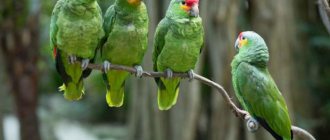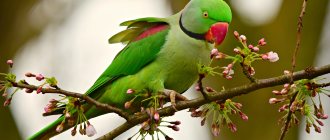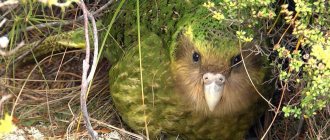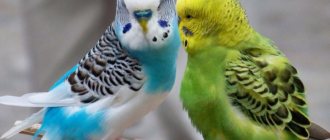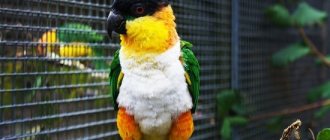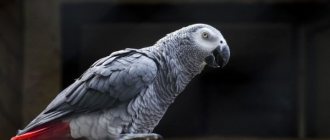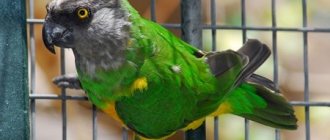Pyrrura (green-cheeked red-tailed parrots) Popular as pets due to their small size, beauty and intelligence, they have captured the hearts of many bird lovers.
Their curiosity, boldness, and playful nature are great traits for pet birds. Mischievous and charming, Pyrrhurs have a lot of personality.
The fact that they are less noisy than most other parrots and more affordable makes them even more attractive.
Temperament of the Green-cheeked Red-tailed Parrot
Pyrrhas are popular pet birds. They are affectionate and playful and love to spend time interacting with their owners.
Like all birds, green-cheeked parrots can be unruly and uncooperative at times, but are generally one of the easiest to behave species.
Although most never speak, the pyrrura is good at training and is known to learn quickly.
They can learn to perform simple tricks. Most Pyrrhur owners say their unique personality makes up for their lack of speech.
Colors and patterns of pyrrura
Males and females have the same coloration. Green-cheeked parrots have multi-colored plumage: bright red feathers on the tail and chest, bright green on the back and wing tips, olive green surrounding a red patch on the chest, and a whitish ring. around the neck, black plumage on the head and olive green spots on the cheeks.
Their long, pointed tail is mostly blue or maroon. They have black beaks and feet, and bare white circles around their eyes.
Several color variations have been selectively bred in captivity, including turquoise, yellowside, cinnamon and pineapple.
Description
Kinds
| Kinds | Photo |
| 1. Blue-throated (blue-throated, ocher, red-eared) Pyrrhura cruentata Vulnerable species | |
| 2. Brown-eared pyrrhura (Burgundy) Pyrrhura frontalis Vulnerable species | |
| Subspecies P. frontalis → Bolivian (firewing) P. devillei Endangered | |
| 3. Red-bellied Pyrrhura perlata Vulnerable species | |
| 4. Pearly Pyrrhura lepida Vulnerable species | |
| 5. Green-cheeked Pyrrhura molinae | |
| 6. Blue-fronted (Panamanian, Azuero) Pyrrhura picta | |
| Subspecies P. picta → | Amazonian (Santarna, Helmira) P. amazonum Endangered
|
| Extinct subspecies of P. picta → | P. subandina P. caeruleiceps P. eisenmanni |
| 7. Madeira Pyrrhura snethlageae Endangered | |
| 8. White-eared (burgundy) Pyrrhura leucotis Vulnerable species | |
| Subspecies P. leucotis → | Venezuelan (emma) P. emma
|
| 9. Gray-breasted Pyrrhura griseipectus Endangered | |
| 10. Red-shouldered (fire) Pyrrhura egregia | |
| 11. Colombian (Santa Marta) Pyrrhura viridicata Endangered | |
| 12. Black-tailed Pyrrhura melanura | |
| 13. El Oro Pyrrhura orcesi Endangered | |
| 14. Black-capped (rocky) Pyrrhura rupicola | |
| 15. White-breasted Pyrrhura albipectus Vulnerable | |
| 16. Luxurious (fiery) Pyrrhura calliptera Vulnerable species | |
| 17. Red-eared parrot Pyrrhura hoematotis | |
| 18. Red-headed (pink-headed) Pyrrhura rhodocephala | |
| 19. Yellowwing Pyrrhura hoffmanni |
Characteristic
| Weight | From 0.08 to 0.1 kg |
| Body length | From 0.22 to 0.29 m |
| Torso | Kneaded, dense |
| Color | Against the background of green, red, yellow, gray, brown, and blue colors appear. |
| Beak | Expanded, with side projections, black or beige. |
| Eyes | Large, black. |
| Paws | Short, strong, with tenacious fingers. |
| Tail | Stepped, reaches 15 cm. |
| Species differences | Birds were classified and named according to their external features - body size and color. |
| Peculiarities | Specific chest design (stripes and scales). |
| Sexual dimorphism | External gender differences are completely absent. The only way to find out gender is by x-ray or DNA test. |
| Features of young animals | The color and beak are lighter than those of adults. |
Caring for Green-cheeked Pyrrura
While the green-cheeked parrot's beauty and intelligence make it an attractive potential pet, the truth is that not everyone can properly care for one.
Parrots are big jobs, requiring daily exercise and companionship, a constant supply of fresh food, and room for their large cage and flight.
The pyrrura may not require the same amount of space as a larger parrot, but you will still need an aviary that is at least 60cm square and 80cm high, with metal bars spaced 0.5 to 1cm apart.
As with any parrot, a bigger cage is always better. Provide several perches that are at least 22cm long and 1.5cm in diameter - varying perch sizes will help keep your parrot's paw flexible.
The Green-cheeked Parrot should get along well with other Pyrrhuras, but they are not housed with other bird species.
If you are keeping more than one bird in a cage, make sure you increase the size of the cage per bird. The more birds you collect together, the larger the cage should be.
In their natural habitat, pyrrhuras live in a school. As a pet, it requires a lot of interaction with you.
Expect that your bird may need two to four hours out of the cage for exercise and socialization each day.
Important Notes
- If you are patient, you can train your parrot to go to the toilet. This can be a very good habit to keep the bird accessible to guests and squeamish family members!
- Before purchasing, make sure you have time to properly care for your bird.
- Read a good book on avian health so you can understand the different diseases and monitor and care for the various aspects of your bird's health.
- Provide your parrot with plenty of clean water to bathe in, ensure that its nails are trimmed frequently, and protect your parrot from ticks. If your bird has mites, visit your veterinarian.
- Beware of general pet stores! Not only do these places not provide the birds with proper care, it will be difficult to make a rational decision when faced with the poor birds in front of you.
- You should always make time for your bird.
- Learn bird body language. This way you can know when your parrot wants attention and when he wants to be alone.
- Clean the cage once a week without fail. The health of the bird depends on this.
- Be prepared for annual molting. This is normal and may take some time. There will be a lot of feathers in the cage, the parrot will be irritable and will scratch to relieve the itching! Be careful with new nibs.
Warnings
- Whenever a child is around a parrot, be sure to supervise it. Even the most tame parrot can bite if startled or irritated, and parrots have powerful beaks that can cause damage.
- Avoid adding too many toys to the cage to allow your bird to move around freely inside.
- Try not to overexert your bird when everyone in the family is spending time with it.
- As with humans, stress has long-term effects on poultry health. Stress can include shaking, diarrhea, rapid breathing, swelling of wings and feathers, poor sleep and loss of appetite. Try to determine the source of the problem (poorly placed cage, pets or children disturbing the bird, constant smell or noise, many people, etc.). Talk to your parrot, reassuring him that things will change now so he can calm down.
- Chocolate, lettuce, avocado and rhubarb are poisonous foods for parrots. Also, do not give them alcohol, candy, chips, pretzels, or seeds/pits from apples, apricots, cherries, peaches, pears, and plums.
What will you need?
- Cage with tray and lid
- Bird toys
- Perches of various sizes
- Bird seeds and other appropriate food. Parrots should not eat seeds alone; they require a pelleted diet supplemented with fresh vegetables. The seeds can be used as occasional supplements and during training.
- Food and water containers
- Bird trainers
- Suitable location for the cage
- Check for household hazards and remove any from the bird's area
General health problems
All parrots are prone to feather plucking, which usually occurs because the birds are bored or neglected.
Green-cheeked Red-tailed Parrots can have a number of common parrot diseases such as Proventricular Dilatation Disease (PDD), a nervous system disorder; psittacine beak and feather disease (PBFD), a deadly virus; psittacosis, bacterial infection; abnormal beak bite or beak misalignment; and aspergillosis, a fungal infection.
Have your bird checked regularly by an avian veterinarian to catch problems early, before they can be easily treated.
How and what to feed pyrrura at home
In the wild, green-cheeked parrots feed on fruits, vegetables, seeds and sometimes insects. Captive poultry should have a similar diet.
For optimal health, feed your parrot a variety of fresh fruits and vegetables supplemented with a high-quality pelleted diet.
The easiest way to incorporate a variety of fresh produce is to use the chopping concept, which involves preparing the salad mix ahead of time.
Living in freedom
Hot Africa has long been the natural habitat of the pyrrhura. The humid climate of tropical forests and subtropical zones seems comfortable to them, so in captivity it is artificially reproduced for birds. Ornithologists call the maximum altitude for colorful parrots to be 3000 meters above sea level.
However, even this high, many dangers await them. Noisy birds with colorful plumage have many enemies. Various terrestrial predators, which destroy birds in large quantities, are not averse to profiting from harmless prey. People also pose a significant threat to parrots. They catch beautiful birds to sell them to Europe. The birds are not always provided with suitable conditions, so they get sick and die along the way.
Exercises
Exercise is extremely important for the Pyrrhura, as it is for all parrots. In the wild, these birds can fly many miles a day in search of food, a mate, or a nesting site.
It's difficult to find the means to replicate this in captivity, but if you can spend at least two hours a day supervising your bird during exercise and play time outside the cage, your bird is likely to remain healthy and happy.
A useful way to achieve this lifestyle is to place a playground stand on top of the cage. This can be a safe place for them to spread their wings while exercising under supervision.
pros
- Social and friendly
- Smart, can teach tricks
- Quieter than other parrots
Minuses
- May not be as noisy, but can still be loud and may not be suitable for apartments
- Requires at least two to four hours of exercise, socialization
How to choose a healthy pet
Pyrrura parrots live 15-20 years and are not cheap. The average price for such a chick is 12-20 thousand rubles. Given the high life expectancy and considerable cost, the choice of a parrot must be approached as responsibly as possible.
You must buy birds from a specialized nursery or from a trusted breeder. At the time of sale, the chick should be no more than 3-4 months old. Young pyrrurs get used to being handled more easily and learn to talk faster.
When choosing a green-cheeked parrot, it is advisable to pay attention to:
- for the availability of accompanying documentation;
- conditions of detention;
- appearance;
- behavior.
Before purchasing, you need to carefully examine your potential pet. He should have clear eyes, a clean cloaca and even plumage. There should be no bald spots on the bird’s body, and no growths or bumps on the legs and beak.
You also need to observe the behavior of the bird. A healthy green-cheeked pyrrura is active and will not sit silently in the corner of the cage.
Green-cheeked pyrrura parrots are little-known birds with bright plumage and unusual behavior. Perky and noisy birds will be a real gift for those who need an unusual pet.
Where to buy pyrrura and their price
Pierrura parrots are quite a popular bird species for keeping at home, so you will not have any problems purchasing this type of parrot.
We found a lot of advertisements for the sale of pierrrura on popular message boards, but personally, I would still prefer to buy myself a pierrrura in a nursery, which are also not so difficult to find on the Internet.
Prices for these exotic parrots range from 2 thousand rubles and above. On average 22-23 thousand, but there are also specimens of 45-50 thousand and above.
Despite the fact that the parrot is gentle and easy to care for, there are times when owners are forced to give up their birds and give them away for free.
If you are considering a bird breeder, make sure you question the breeder, look at the general health of their birds, check their living conditions, and talk to past clients.
Signs that a breeder should be avoided include cramped living conditions, sedentary birds, and breeders who avoid your questions or don't have enough information about their birds.
Features of life in the wild
Habitat
South American countries:
- Brazil,
- Venezuela,
- Argentina,
- Paraguay,
- Bolivia,
- Uruguay,
- Peru,
- Chile.
They prefer to live in damp, dense forests near rivers, as well as in wooded areas of the foothills. Some subspecies settle near farmland.
Nutrition
Cereals, herbs, seeds, fruits, berries, young shoots of plants.
Reproduction
To live and build nests, birds choose hollows located high from the ground. After a short mating season, the female lays 2 to 9 eggs and incubates them. During incubation, the male guards the nest and feeds the female. The offspring are born after 21-29 days. Both parents are involved in feeding the offspring. At 1.5 months of age, the chicks begin to fly out of the nest, but finally part with their father and mother after 3 months. Parrots become sexually mature by the age of 2 years.
Features of behavior
When flying, they are able to abruptly change direction - from vertical to horizontal and vice versa.
Lifespan
Wild Pyrrhurs rarely live past 10 years. Among the reasons for such a short life cycle:
- Avian infectious diseases.
- Deforestation.
- Poisoning of fields and reservoirs with chemicals and toxic substances.
- Poaching.
- Fires.
- Droughts.




